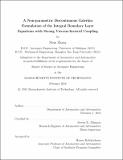| dc.contributor.advisor | Steven R. Allmaras. | en_US |
| dc.contributor.author | Zhang, Shun (Aerospace scientist) Massachusetts Institute of Technology | en_US |
| dc.contributor.other | Massachusetts Institute of Technology. Department of Aeronautics and Astronautics. | en_US |
| dc.date.accessioned | 2018-11-28T15:25:25Z | |
| dc.date.available | 2018-11-28T15:25:25Z | |
| dc.date.copyright | 2018 | en_US |
| dc.date.issued | 2018 | en_US |
| dc.identifier.uri | http://hdl.handle.net/1721.1/119272 | |
| dc.description | Thesis: S.M., Massachusetts Institute of Technology, Department of Aeronautics and Astronautics, 2018. | en_US |
| dc.description | This electronic version was submitted by the student author. The certified thesis is available in the Institute Archives and Special Collections. | en_US |
| dc.description | Cataloged from student-submitted PDF version of thesis. | en_US |
| dc.description | Includes bibliographical references (pages 117-121). | en_US |
| dc.description.abstract | A non-parametric discontinuous Galerkin (DG) finite-element formulation is developed for the integral boundary layer (IBL) equations with strong viscous-inviscid coupling. This DG formulation eliminates the need of explicit curvilinear coordinates in traditional boundary layer solvers, and thus enables application to complex geometries even involving non-smooth features. The usual curvilinear coordinates are replaced by a local Cartesian basis, which is conveniently constructed in the DG finite-element formulation. This formulation is also applicable to the general convection-source type of partial differential equations defined on curved manifolds. Other benefits of DG methods are maintained, including support for high-order solutions and applicability to general unstructured meshes. For robust solution of the coupled IBL equations, a strong viscous-inviscid coupling scheme is also proposed, utilizing a global Newton method. This method provides for flexible and convenient coupling of viscous and inviscid solutions, and is readily extensible to coupling with more disciplines, such as structural analysis. As a precursor to the three-dimensional strongly-coupled IBL method, a two-dimensional IBL solver coupled with a panel method is implemented. Numerical examples are presented to demonstrate the viability and utility of the proposed methodology. | en_US |
| dc.description.statementofresponsibility | by Shun Zhang. | en_US |
| dc.format.extent | 121 pages | en_US |
| dc.language.iso | eng | en_US |
| dc.publisher | Massachusetts Institute of Technology | en_US |
| dc.rights | MIT theses are protected by copyright. They may be viewed, downloaded, or printed from this source but further reproduction or distribution in any format is prohibited without written permission. | en_US |
| dc.rights.uri | http://dspace.mit.edu/handle/1721.1/7582 | en_US |
| dc.subject | Aeronautics and Astronautics. | en_US |
| dc.title | A non-parametric discontinuous Galerkin formulation of the integral boundary layer equations with strong viscous-inviscid coupling | en_US |
| dc.type | Thesis | en_US |
| dc.description.degree | S.M. | en_US |
| dc.contributor.department | Massachusetts Institute of Technology. Department of Aeronautics and Astronautics | |
| dc.identifier.oclc | 1062360199 | en_US |
